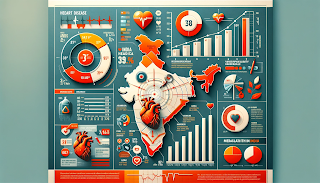Revolutionizing Cardiac Care in India: My Journey with Sampurna Hriday Shuddhikaran
By Dr. Rohit Sane, Founder of Madhavbaug, Chairman and Managing Director
In the heart of India's healthcare landscape, amidst the
rising tide of cardiovascular diseases, stands a beacon of hope: the Sampurna
Hriday Shuddhikaran (SHS) model. As the founder of Madhavbaug and a dedicated
heart care specialist, I am excited to share our innovative approach to
combating Chronic Heart Failure (CHF) and its promising results.
Understanding India's Heart Health Crisis
India's struggle with cardiovascular diseases is alarming.
In 2019, 65% of all deaths in the country were due to noncommunicable diseases,
with cardiovascular diseases accounting for a significant portion. By 2021,
age-standardized mortality rates for cardiovascular diseases in South Asia,
including India, ranged from 248.6 to 350.9 per 100,000 persons. These
statistics highlight the dire need for effective cardiac care solutions in the
country.
The Genesis of Sampurna Hriday Shuddhikaran
The SHS model, a novel approach blending traditional herbal
treatments with exercise protocols, was developed in response to the growing
burden of CHF. In our study published in the "Journal of US-China Medical
Science" in 2011, we delved deep into the impact of this model on CHF
patients.
Empirical Evidence of SHS's Effectiveness
Our research involved 200 patients with an average age of 55 years who underwent the SHS treatment. The results were encouraging:
- Six
Minute Walk Test: Patients showed an average increase of 70.6 meters.
- Stress
Test: Improvement of 132.10 seconds.
- Metabolic
Equivalents: Increase of 2.114.
- VO2 Max: Increase of 3.10.
These findings represent a significant improvement in the
exercise tolerance of CHF patients, indicating better overall heart health and
quality of life.
The SHS Treatment Protocol
The SHS protocol includes four stages:
- Snehan: A centripetal sesame oil massage, known for its antioxidant properties.
- Swedan:
Thermal therapy to reduce salt and water retention.
- Hrid
Dhara: A warm herbal decoction targeted at the chest area.
- Basti:
An enema using Terminalia arjuna decoction, a herb renowned for
strengthening heart muscles.
Transforming Lives Beyond Numbers
The success of the SHS model is not just in the numbers but
in the stories of our patients who have experienced a marked improvement in
their symptoms and overall well-being.
Madhavbaug's Mission: A Heart-Healthy Future
Our journey with SHS is more than just a medical study; it's a commitment to transforming cardiac care in India. At Madhavbaug, we are dedicated to continuing our mission of innovation in cardiac rehabilitation, making heart health more accessible and holistic.
Dr. Rohit Sane

%20therapy%20to%20match%20the%20theme%20of%20the%20Madhavbaug%20logo.%20The%20image%20should%20mai.png)


Comments
Post a Comment